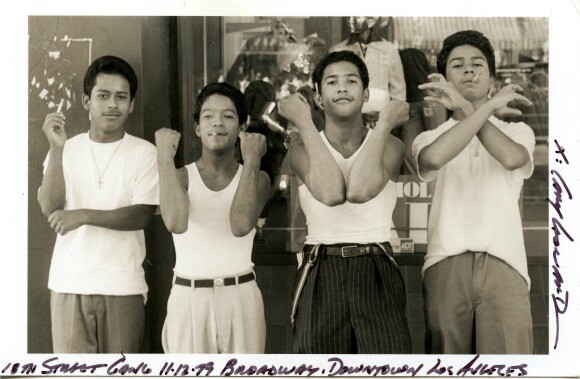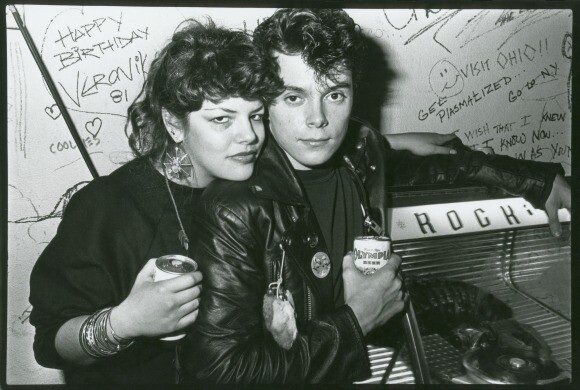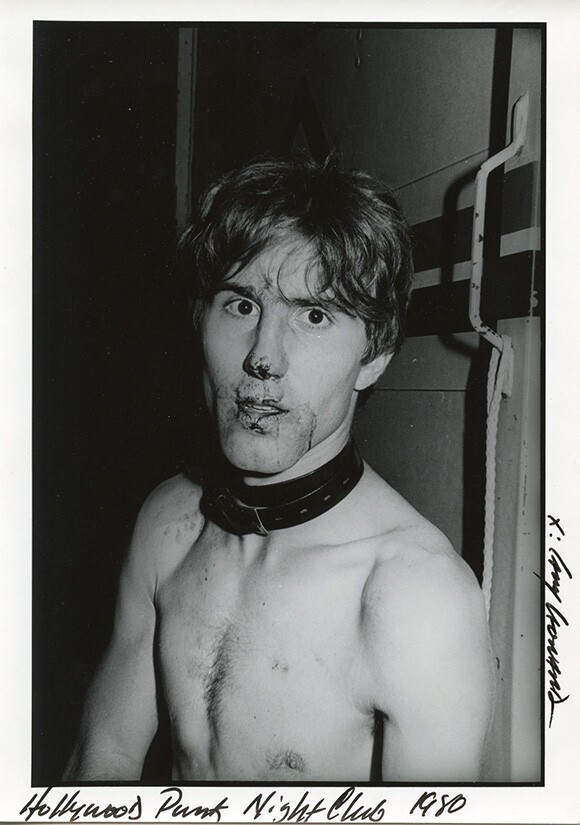Gary Leonard's Photographic Amber

Part Diane Arbus, part Weegee and a lot of fisheye lens-work, Gary Leonard's indelible style is instantly recognizable: be they candid portraits of politicians, punk rockers or celebrities major and minor; cityscapes where car washes, Cadillacs and conventions thrum on; or the odd signs that both litter and make light of our lives, Leonard has preserved them all in his own photographic amber.
One might even say that Gary Leonard's name is synonymous with Los Angeles. Indeed, the photographer, born in 1951 in Encino and living in Echo Park since 1979, has been a fixture on the photojournalism scene since first picking up a camera at age eight, when he attended a Dodger Photo Day and shot the home-run hitting center fielder, Duke Snider.
From that auspicious outing, Leonard continued to fix his discerning eye on hundreds of thousands of subjects in order to capture the essence of the City of Angels.


In fact, Leonard's most recent exhibition, "City of Angels: Portraits," a collaborative show with artist Colette Miller is hanging in the north ambulatory Art Chapel at the Cathedral of Our Lady of the Angels, the Rafael Moneo-designed edifice at the corner of Temple and Grand downtown.
On view through mid-August, the 32 portraits feature a range of Angelenos standing in front of a pair of angelic wings that Miller painted as a backdrop on a roll-up door at 446 South Main Street.
The gray-haired, hazel-eyed Leonard, who is never without a camera -- or two -- recalled the genesis of the exhibition: "I know so many people of different backgrounds, and I've always thought, 'Wouldn't it be great if there were an event where every kind of person I've known and encountered would come to me.'"
Leonard went on to say that Joe Moller, who ran the monthly downtown Art Walk, emailed him about Miller's wings at the Regent Theater, prompting the photographer to drive by and check them out. "A friend of Colette's walked by the wings and I immediately had an epiphany -- the wings would become the unifying factor."


Among the subjects are past, present and erstwhile hopeful mayors, including Eric Garcetti, mayoral candidate Wendy Gruel and former mayors Antonio Villaraigosa -- sporting sunglasses -- and Richard Riordan, who brought a group of school kids with him from Frederick Douglass Academy Elementary.
"I'm still trying to get Jim Hahn," said Leonard of the 40th mayor of Los Angeles, who gave Leonard a thumbs-up when the photographer threw his own hat into the political morass known as the 2003 gubernatorial recall election that saw Arnold Schwarzenegger become California's 38th governor.
Other wing-sprouting denizens are faces familiar to downtown, including developer Tom Gilmore, who posed with his father, and Patt Morrison, the journalist always seen sporting a large chapeau. Writer Louise Steinman, curator of the ALOUD series at the Downtown Central Library (Leonard is that series' official photographer), was captured in mid-air, prompting Leonard to quip, "She's on her way -- to heaven."


And no Leonard photo exhibition would be complete without a homeless person or city worker. In this case a street cleaner is sprouting wings as he hoses down the sidewalk.
"And this is Officer Montenegro," Leonard pointed to his portrait of a motorcycle cop, a bemused look on his face. "I have a picture I took of him on the curb. He had just pulled someone over and was giving that person a ticket -- and you can see the wings in the background.
"Then he stood in front of the wings," Leonard continued. "Look how happy he is. He'd just made his quota. I'm kind of kidding -- I don't really think he was smiling because of that."
Each of the 16 x 20 inch photographs, which are not matted, but float in warm-toned frames, is labeled, even if it's "Unnamed" or "Anonymous." Explained Leonard: "We hope that during the exhibit that people would see themselves and tell us their names."


In total, Leonard took more than 300 photographs, beginning in February of 2013, all of which were looped on a video monitor as part of an exhibit that was held at the Fine Arts Building last year. That show also featured 17 portraits that became part of the Cathedral exhibition.
Miller, who has lived downtown for 14 years, said she had heard of Leonard over the years but hadn't really known him until the angel wings project. She had originally painted a pair of wings in her studio, then glued them onto a downtown wall in the Arts District, guerilla-style and without permission.
"I was meditating a lot and driving around L.A.," recalled Miller, "and kept seeing really big wings in my mind on the city's industrial walls. I thought it would just be such an enlightening thing to see."
"Thanks to Gary Leonard, they took a different level that most street art never does. I was grateful for that," added Miller, who described the photographer's style as "pristine and dignified, yet of the street."


Miller eventually got permission to put the feathered appendages on the metal roll-up door at the Regent Theater, a Tom Gilmore-owned building that is leased by nightclub and restaurant owner Mitchell Frank, whose three sons are also pictured in the Cathedral exhibition.
And with all the attention they've been generating, it does seem as if these wings have, well, legs.
Anne Stein, a film editor and Leonard's partner for a number of years, said that in addition to the Fine Arts exhibition, seven of the angel portraits, displayed in light boxes, were chosen by theMTAto rotate through various subway stations during the last six months.
It was also Stein who curated the Cathedral show, which opened on May 17, as part of the Catholic church's Sunday mass.
"Gary had a walk-up with the wafer," recalled Stein, "and it was kind of a strange sermon. But the music perked it up a bit and in the end [the sermon seemed] more relevant.
"Then," she added, "everybody walked by the pictures and people were responsive, but frankly," Stein said, "wings are cliché. It's not like we're dealing with specific clichés. It just gives people an excuse to pose in a relaxed manner, [so] if you're aware of the cliché, it becomes an asset."
When asked what criteria she used in choosing the subjects, Stein said she considered the locale, a church.
"We wanted it to be a range -- a blend of working class people to highly recognizable people, as well as kids. The church has done a whole series of tapestries in the main room that signify the saint as ordinary people," added Stein, "and that's what we talked about -- that everybody was equal.
"It needed to be a populous approach," added Stein, "which is the way Gary shoots all his stuff."


Leonard, who is rarely seen sans camera, has also exhibited in numerous solo and group shows, with some of his images part of the California State Library collection of historic California photography, as well as part of the history department at the Downtown Central Library.
It was a small, but elegant book he happened upon (and still keeps in his car), David Gebhard and Robert Winter's "A Guide to Architecture in Southern California," published by LACMA in 1965, that first inspired him to look at the city's architecture, which he has done -- and keeps on doing -- with an artistic vengeance.
Leonard's own books include "Make the Music Go Bang," a collaboration with one-time music critic Don Snowden (1997), and "Take My Picture Gary Leonard" (1998), both having proven an elixir for Angelenos in need of a pop culture fix, Gary Leonard style.
The artist also spent 11 years shooting photos for his book, "Symphony In Steel: Walt Disney Concert Hall Goes Up." He was there from day one, in 1992, when ground was broken on the iconic venue, until completion in 2003, never missing a beat -- or a photo op.


From taking portraits of the architect Frank Gehry, then Mayor Riordan and a visiting Prince Andrew in late 2000, to capturing the first piece of stainless-steel cladding that hugged the framework like a high-glossed cocoon, the chronicler of Los Angeles was an ubiquitous presence.
These days Leonard continues his gig as staff photographer for the Los Angeles Downtown News, which, along with LAObserved, publishes his column, "Take My Picture Gary Leonard." He also has his own gallery space on Broadway at Ninth Street.
It's called -- what else -- Take My Picture Gary Leonard, with the photographer's son, David Leonard, its creative director. The current exhibition features black and white portraits of punk scenesters and is from a show Leonard first mounted in 1991 at the after-hours club, Zero/Zero.
After shooting photographs for some five decades, Leonard has amassed quite the archive. Included are subjects ranging from the Dalai Lama and the Del Rubio Triplets, to Black Panther Eldridge Cleaver -- both alive at Jerry Rubin's funeral in 1994 and then dead in his own casket in 1998. Film and art notables, such as Bob Hope, David Hockney and former Warhol star, Joe Dallesandro, are also in the vast collection.
Leonard is currently outfitting a 1,200-square foot workspace at Fourth and Main with a countertop and sink that will eventually become his darkroom. Then, Leonard said, he will be able to once again make prints from his huge cache of negatives.


"This space allows me to move everything out of storage and put them all in bookcases and organize not only the negatives, but also all the prints and ephemera that I've collected over the last 40 or 50 years, so that it's in a fashion where, I guess, people will want to buy it."
Having turned 64 last April, Leonard said he's beginning to feel his mortality.
"Part of the effort I'm trying to make now," explained Leonard, "is to get everything in proper order. How much time do you think I have left?" he asked rhetorically.
"I could go tomorrow," Leonard added. "Look at [artist] Richard Duardo -- he dropped dead. Well, he didn't wake up, he went in his sleep, and he's a couple years younger than I am. But I'm in really good health and hopefully that's not the case. The idea is to get my stuff in order."
Leonard said that with L.A. becoming more and more of a creative hotbed, it makes sense that his collection would be in demand.
"There's a lot of everything in my collection. It's a time period -- a time capsule," Leonard explained, "and what I'm discovering, and I'm flattered by, is that I'm getting calls from academics. That's what you hope for."
"And that's what I always assumed would happen," he continued, "but when it happens it's weird. What I produce, that's really the art, and I am kind of all these things -- a documentarian, an artist, a photojournalist, a printer, a collector, someone who hoards things. All these different labels can be put on me."

But his greatest struggle, admitted Leonard, is that he still wants to cover everything -- the events, people, places and things -- that make Los Angeles the palm-tree-paradise-with-a-noir bent city that it is.
"I had to be there with the camera and the best way of doing that was to work as a photographer at the same time. And I've still had to make choices. Do I go here when I could be over there? The conflict is that I'll always be missing something."
Before he walked off to shoot yet another subject -- documenting construction workers and the rise of what will be the 73-story Wilshire Grand/InterContinental -- Leonard remarked: "Everybody has a camera today -- your iPhone is your camera. So I have this archive where everybody didn't have a camera."
"It's almost an antidote to the way photography's moving. It makes it the perfect time to go back, reflect and introduce these images that now, with all this time, do have the value that I had anticipated."






Dig this story? Sign up for our newsletter to get unique arts & culture stories and videos from across Southern California in your inbox. Also, follow Artbound on Facebook, Twitter, and Youtube.


